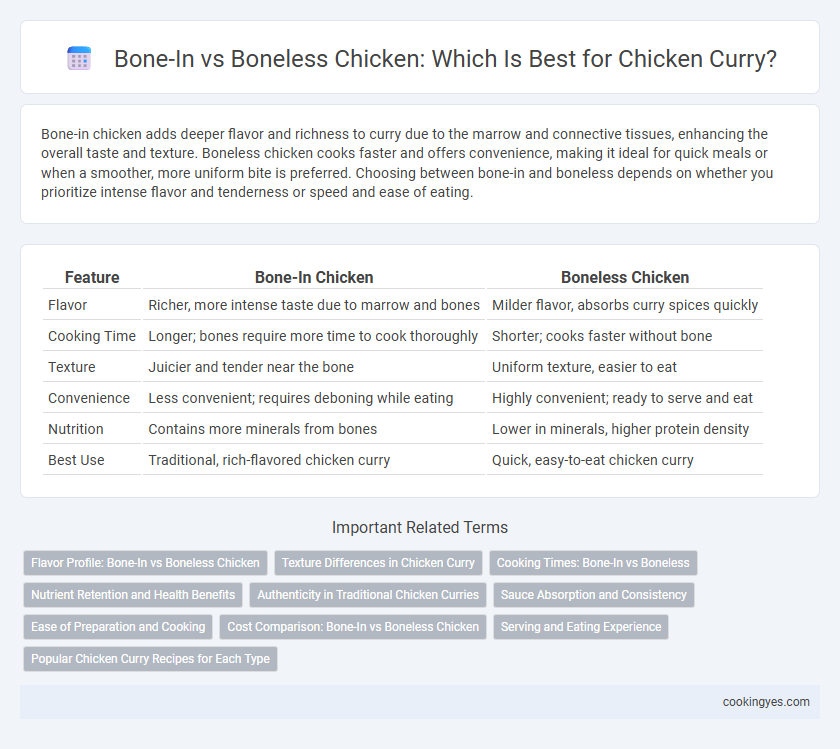Bone-in chicken adds deeper flavor and richness to curry due to the marrow and connective tissues, enhancing the overall taste and texture. Boneless chicken cooks faster and offers convenience, making it ideal for quick meals or when a smoother, more uniform bite is preferred. Choosing between bone-in and boneless depends on whether you prioritize intense flavor and tenderness or speed and ease of eating.
Table of Comparison
| Feature | Bone-In Chicken | Boneless Chicken |
|---|---|---|
| Flavor | Richer, more intense taste due to marrow and bones | Milder flavor, absorbs curry spices quickly |
| Cooking Time | Longer; bones require more time to cook thoroughly | Shorter; cooks faster without bone |
| Texture | Juicier and tender near the bone | Uniform texture, easier to eat |
| Convenience | Less convenient; requires deboning while eating | Highly convenient; ready to serve and eat |
| Nutrition | Contains more minerals from bones | Lower in minerals, higher protein density |
| Best Use | Traditional, rich-flavored chicken curry | Quick, easy-to-eat chicken curry |
Flavor Profile: Bone-In vs Boneless Chicken
Bone-in chicken enhances curry flavor by releasing collagen and marrow during cooking, enriching the sauce with a deep, savory taste and richer texture. Boneless chicken offers convenience and quicker cooking times but often results in a milder flavor profile due to the absence of bone-derived elements. Selecting bone-in cuts like thighs or drumsticks maximizes the curry's umami and complexity, making the dish more robust and satisfying.
Texture Differences in Chicken Curry
Bone-in chicken curry offers a richer, more succulent texture as the bones release gelatin and marrow during cooking, enhancing mouthfeel and depth of flavor. Boneless chicken pieces provide a tender and uniform texture that absorbs spices quickly, allowing for a more consistent taste throughout the curry. The choice impacts the overall eating experience, with bone-in delivering a heartier bite and boneless offering ease of consumption and quicker cooking times.
Cooking Times: Bone-In vs Boneless
Bone-in chicken typically requires 40 to 50 minutes to cook thoroughly in curry, allowing the marrow to infuse rich flavors into the sauce. Boneless chicken, such as thighs or breasts, cooks faster, usually within 20 to 30 minutes, making it ideal for quicker meals. Adjusting cooking times based on chicken type ensures tender meat and perfectly balanced curry.
Nutrient Retention and Health Benefits
Bone-in chicken retains more nutrients and minerals like calcium and phosphorus, enhancing the nutritional profile of chicken curry. The slow cooking process extracts collagen and gelatin from the bones, which support joint health and improve digestion. Boneless chicken offers convenience and lower fat content but lacks the added health benefits derived from bone marrow and connective tissues.
Authenticity in Traditional Chicken Curries
Authentic traditional chicken curries predominantly use bone-in pieces, as the bones release rich gelatin and marrow that enhance the depth of flavor and texture in the curry. The marrow infuses the sauce with nutrients and umami, creating a robust, hearty taste that boneless chicken cannot replicate. Using bone-in chicken preserves the cultural cooking techniques that emphasize slow simmering to extract maximum flavor essential for genuine curry authenticity.
Sauce Absorption and Consistency
Bone-in chicken enhances sauce absorption in chicken curry by releasing natural gelatin and marrow during cooking, resulting in a richer, thicker consistency. Boneless chicken cooks faster and allows the curry sauce to coat the meat more evenly, but it lacks the depth of flavor contributed by bones. Choosing bone-in pieces improves the curry's overall texture and intensifies the sauce's savory profile.
Ease of Preparation and Cooking
Bone-in chicken provides richer flavor and retains moisture during cooking, enhancing curry depth but requires longer preparation and careful handling to avoid bone fragments. Boneless chicken cooks faster and simplifies preparation, ideal for quick meals and consistent texture in curries. Choosing between bone-in and boneless depends on balancing cooking time with desired flavor intensity in chicken curry dishes.
Cost Comparison: Bone-In vs Boneless Chicken
Bone-in chicken typically costs less per pound than boneless, skinless chicken, making it a more budget-friendly option for chicken curry recipes. The presence of bones adds weight, resulting in a lower price per edible portion compared to boneless cuts, which are more labor-intensive to prepare and therefore priced higher. Choosing bone-in chicken can reduce overall meal costs without compromising flavor, as the bones enhance richness during cooking.
Serving and Eating Experience
Bone-in chicken curry offers a richer, more flavorful experience as the bones release gelatin and marrow during cooking, enhancing the sauce's depth and texture. Serving bone-in pieces encourages a slower, more interactive dining experience, often preferred in traditional or communal meals. Boneless chicken provides convenience and ease of eating, making it ideal for quick servings and dishes where a smooth, uniform texture is desired without the need to navigate around bones.
Popular Chicken Curry Recipes for Each Type
Bone-in chicken curry recipes, such as traditional Indian chicken curry and Thai green curry, are favored for their rich flavor and tender meat infused with the marrow's depth, enhancing the overall taste. Boneless chicken curry recipes, including butter chicken and chicken tikka masala, offer convenience and faster cooking times, making them ideal for quick meals without sacrificing flavor. Popular recipes highlight how bone-in cuts provide a more robust, slow-cooked experience, while boneless options cater to ease of eating and versatile preparation methods.
Bone-In vs Boneless for Chicken Curry Infographic

 cookingyes.com
cookingyes.com